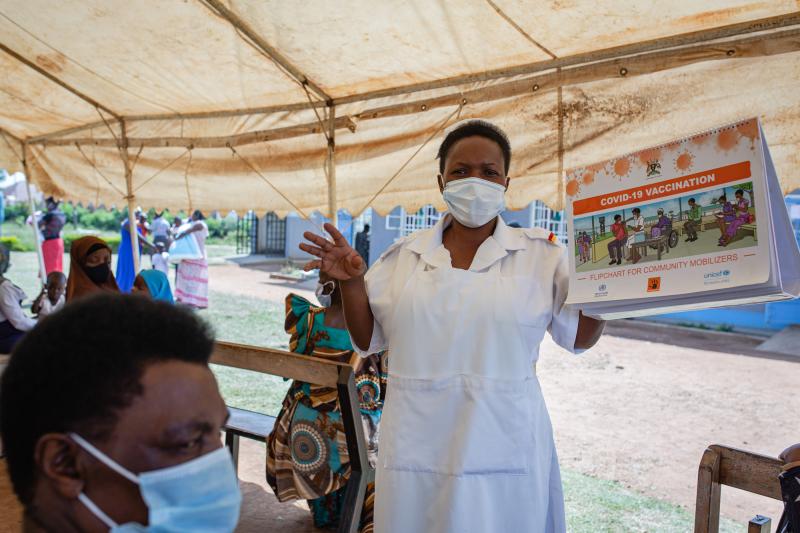Where We Work
See our interactive map


A health worker talks to waiting clients about COVID-19 vaccinations at Nakaloke Health Center III in Mbale, Uganda. Photo by Esther Ruth Mbabazi for IntraHealth International.
Tens of thousands of Ugandans accessed COVID-19 vaccines in 2021 thanks to IntraHealth International’s partnership with the government of Uganda, district cold chain technicians, and the Mbale and Soroti Regional Emergency Operations centers. Together, we redistributed over 40,000 vaccines, 23,000 vaccination cards, and 25,000 syringes.
Uganda has had over 163,000 confirmed cases of COVID-19 with 3,588 deaths. In January, they relaxed many COVID-19 prevention measures which had included curfews, business and school closures, and border closings, among others. They’ve received over 22 million doses of different COVID-19 vaccines from the COVAX Facility and US government and have vaccinated 15 million people. But demand hasn’t always met supply and many districts in Uganda faced vaccine shortages. In other words, Uganda had available vaccines, but they weren’t in the right place.
Growing myths about COVID-19 persist in the country, which fuels vaccine hesitancy and lack of proper prevention measures. As part of the USAID-funded Regional Health Integration to Enhance Services in Eastern Uganda (RHITES-E) project, IntraHealth has been working with the government to help respond to and prevent the spread of COVID-19 in health facilities and communities by working with health workers—a crucial component to mitigate vaccine hesitancy and get shots in arms— and using approaches such as risk communication, case management, and surveillance. So when it was clear vaccines needed to be redistributed, IntraHealth used existing networks and relationships to send vaccines to the Pallisa, Butebo, Mbale, Manafwa, Butaleja, Namisindwa, and Tororo districts.
In total, IntraHealth helped redistribute:
The success of the redistribution was dependent on the district cold chain technicians who make sure the vaccine is properly handled and stored throughout the life of the vaccine. Vaccines must be stored in temperature-controlled environments—from time of manufacture to jab—to ensure its potency. IntraHealth worked with cold chain technicians in each district who ensured proper vaccine storage and managed daily stock data, which informed vaccine distribution quantities.
Vaccine redistribution is just one step toward vaccinating Uganda’s citizens. Like most countries, they’re experiencing other hurdles such as vaccine hesitancy, lack of health worker training, and limited service sites. So IntraHealth collaborated with the Ugandan government to expand vaccination service points out to all health center IIIs in addition to hospitals and health center IVs, conduct outreach in addition to static sites, and help health workers build their vaccination skills.
IntraHealth also trained 378 health workers in nine districts on the new COVID-19 vaccines to ensure that all health workers providing COVID-19 vaccinations have adequate knowledge and skills on how to administer them properly. And RHITES-E is strengthening community awareness about COVID-19 and its preventive measures through community mobilization, sensitization, and helpful communication materials with COVID-19 prevention messages.
Because vaccine hesitancy still exists, and Uganda hopes to vaccinate all of its citizens, IntraHealth continues to work with the government and district health centers to roll out vaccines, train health workers, and mobilize the community.
The Regional Health Integration to Enhance Services in Eastern Uganda (RHITES-East) program is led by IntraHealth International and funded by the US Agency for International Development.



